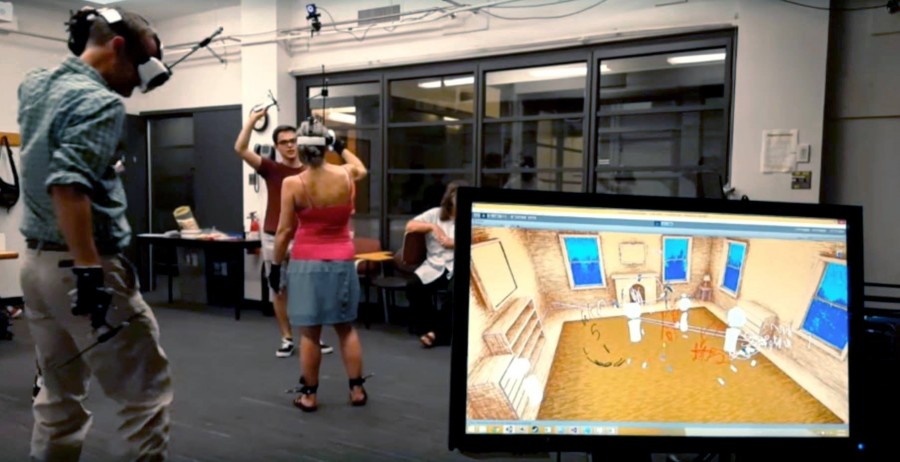Virtual Reality Is Basically Just Reality Now, Thanks to This NYU Professor
NYU graduate students and faculty test Holojam, a virtual reality headset created by NYU Professor, Kenneth Perlin.
February 26, 2016
Virtual reality is no longer a thing of science fiction, but rather a reality being nurtured at NYU. Computer science professor Kenneth Perlin has created a virtual reality headset called Holojam and is now developing ways to allow multiple users to simultaneously enter a world as vivid and colorful as a child’s storybook.
The demand for virtual reality technology has exploded in the last few years. Films using virtual reality have the ability to immerse viewers in a completely different environment, and businesses such as Oculus have the potential to create an $80 billion dollar industry. Just this semester, NYU became one of the first universities in the country to teach a course dedicated to the creation of virtual worlds.
The equipment used by Holojam is designed to immerse two people in the same virtual reality space without the constraints of wires. Instead of messy cables, the team uses optical markers linked to motion tracking cameras fixed to the players.
NYU graduate students and faculty volunteer once a week to test the new technology in one of the university’s computer science buildings. In an interview with Motherboard, Holojam’s senior artist David Lobser said the volunteers could be a handful, but that this gives the team a valuable opportunity to talk, plan and code with prospective users.
“Students come with fewer preconceptions, whereas people such as us have been doing this a long time,” Lobser told Motherboard. “Having minds that are more of a blank slate forces us to question our own assumptions, too.”
PhD student Michael Musick, who works on the Holojam project, said researchers in the virtual reality field are working towards developing shared, interactive media environments rather than just isolated, individual experiences.
“The internet has brought us back together, whereas previous evolutions in technology –– the road, printing press, recording technology –– allowed society to expand outwards,” Musick said. “We will continually find ourselves as a society becoming more intertwined with each other. I believe immersive, shared virtual reality experiences will be part of this evolution.”
In addition, Musick said virtual reality will make it possible for participants to share experiences without needing to live in close proximity to each other.
“Internet-based video chatting has allowed people to communicate with more intimacy,” Musick said. “Internet-based virtual reality will further this progression.”
Gallatin freshman Zayna Quader said she was excited for the development of virtual reality, but anxious about possible consequences in social development.
“There may be a danger of people becoming addicted to the virtual reality and forgetting about their real lives, but that mostly comes from movies that I’ve watched,” Quader said.
Perlin said virtual reality would not encourage isolation. Musick however, was not as certain.
“Maybe, maybe not,” Musick said. “As with social media and the internet in general, it is all about having conversations and educating potential users.”
The rise of virtual reality exhibits our society’s rapid technological advancement. There is no doubt that virtual reality will become an integral part of society, just as cell phones and laptops have. But when this technological advancement such as Perlin’s work and research will become popular among the general public is hard to pinpoint.
Email Kate Howard at [email protected].

























































































































































Shaurya • Feb 27, 2016 at 8:50 am
I want to study at NYU. Virtual reality is my passion!